Mastering Training Techniques for Your German Shepherd


Intro
Training a German Shepherd not to bite is a fundamental aspect of responsible pet ownership. These intelligent and strong-willed dogs possess a natural instinct to protect, which can sometimes manifest as biting, particularly when they feel threatened or anxious. Addressing this behavior early plays a critical role in ensuring a harmonious living environment for both the pet and the owner. In this article, we'll explore various methods to effectively train your German Shepherd, focusing on not just the immediate behaviors but also the underlying causes and motivations for biting.
We’ll delve into essential pet care, behavioral understanding, and ways to create a welcoming environment. This will help pet owners grasp the significance of their dog's needs and behaviors while fostering safe interactions with the community.
Pet Care Essentials
Training incidents cannot be addressed successfully if the overall care of the German Shepherd is neglected. Let’s break this down further into individual components that contribute to the pet's well-being and behavioral harmony.
Daily Nutrition Requirements
Providing balanced nutrition is key to maintaining a well-behaved German Shepherd. Feeding them high-quality dog food rich in protein, vitamins, and minerals is important. A recommended diet should include:
- Lean meats (like chicken or beef)
- Whole grains (such as brown rice or oats)
- Fruits and vegetables (for added vitamins)
Avoid foods that are toxic to dogs, like chocolate or onions. Always ensure that fresh water is available, encouraging hydration, especially after exercise.
Exercise and Playtime
German Shepherds are active by nature and require regular exercise to keep them mentally and physically fit. Engaging in:
- Daily walks
- Play sessions with toys like discs or balls
- Structured activities such as agility training
This not only reduces restlessness but also promotes good behavior. A tired dog is often a well-mannered dog, reducing incidents of biting out of boredom or pent-up energy.
Grooming Tips
Frequent grooming helps in maintaining your dog’s coat and hygiene, and it's also crucial to their comfort. Regularly brush their fur to reduce shedding and keep their skin healthy. Bathing should be done as needed, typically every few months, using dog-specific shampoos to avoid skin irritation.
Health and Wellness Check-ins
Routine check-ups with a vet are necessary to catch any health problems early. Keeping up with vaccinations and prevention methods for fleas and ticks aids in overall well-being. Look for behavioral changes; a sudden inclination to bite may signify discomfort or pain that needs attention.
Behavior & Training
Understanding and addressing biting behavior involves a deep dive into your pet's psychology, their body language, and applying effective training techniques.
Understanding Your Pet's Body Language
Being equipped with the knowledge of your German Shepherd’s body language can be invaluable. Common signs indicating discomfort or potential aggression can include:
- Pinned ears
- Low posture
- Bared teeth
Recognizing these signs early can help in redirecting behavior before it escalates into biting.
Basic Training Techniques
Employing positive reinforcement is one of the most effective training strategies. Rewarding desirable behavior with treats, praise, or playtime can condition your German Shepherd to repeat that behavior. Some essential commands to teach include:
- Sit
- Stay
- Leave it
Consistency is key. Make training a routine, infusing patience into the process to avoid frustration for both you and your pup.
Behavioral Concerns & Solutions
For dogs with a tendency to bite, identifying triggers can really help. Consider keeping a journal to track their reactions in various situations. For instance, if your dog bites when meeting new people, working on socialization may be necessary.
Possible solutions could involve:
- Gradual introductions to new environments
- Controlled playdates with other dogs
- Obedience classes to structure interactions
Socialization Tips
Socializing a German Shepherd is not merely about allowing them to play with other dogs; it’s about exposing them to various situations, people, and environments to build their confidence. Systematic desensitization will help them learn how to behave in a multitude of settings without feeling the need to bite.
Finale
As we explore these strategies, the goal is to create a well-adjusted German Shepherd that feels secure and interacts positively with their environment. Understanding their needs and behaviors plays a significant role in shaping them into both beloved family pets and respected members of the community.
Understanding the Nature of German Shepherds
When it comes to training a German Shepherd, having a solid grasp of the breed's instinctual behaviors and characteristics is vital. This understanding lays the groundwork for effective training strategies to mitigate biting behavior. By recognizing the unique qualities of this breed, pet owners can tailor their training approaches to align with the dog's natural tendencies, ultimately fostering a safer and more enjoyable relationship.
Breed Characteristics and Instincts
German Shepherds display a range of characteristics that make them exceptional companions and working dogs. Known for their intelligence, loyalty, and protective nature, these dogs originated as herding animals, which influences much of their behavior. Their instinct as herders gives them an innate drive to guide and protect, which can manifest in unwanted biting or nipping if not properly managed.
Additionally, German Shepherds are highly energetic and require mental stimulation. A lack of physical activity or mental engagement may lead to pent-up energy, prompting undesirable behaviors, including biting. Owners should consider engaging their dogs in tasks that mirror their herding instincts, such as agility training or obedience exercises. Recognizing these traits helps in crafting a training regimen that channels their energy positively, reducing the likelihood of aggressive behaviors.
Furthermore, their natural curiosity can lead them into situations that may provoke fear or anxiety. Understanding the breed’s tendencies toward sensitivity in certain environments or with unfamiliar stimuli can guide owners on how to approach training with patience and awareness. This knowledge is integral for owners who wish to cultivate a well-mannered dog that also feels secure in various situations.
Common Behavioral Traits
Every dog has its quirks, but German Shepherds come with a set of common traits that can impact their behavior. For instance, they tend to be very social and often form strong bonds with their families. This loyalty, while a wonderful aspect of their nature, can also lead to possessiveness over their owners or belongings, which might escalate into biting if they feel threatened.
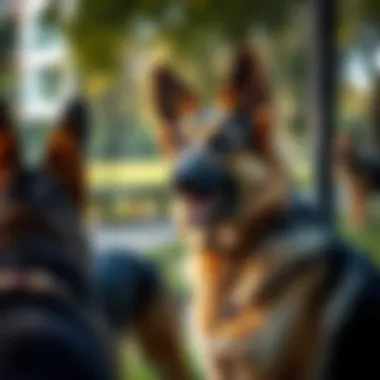
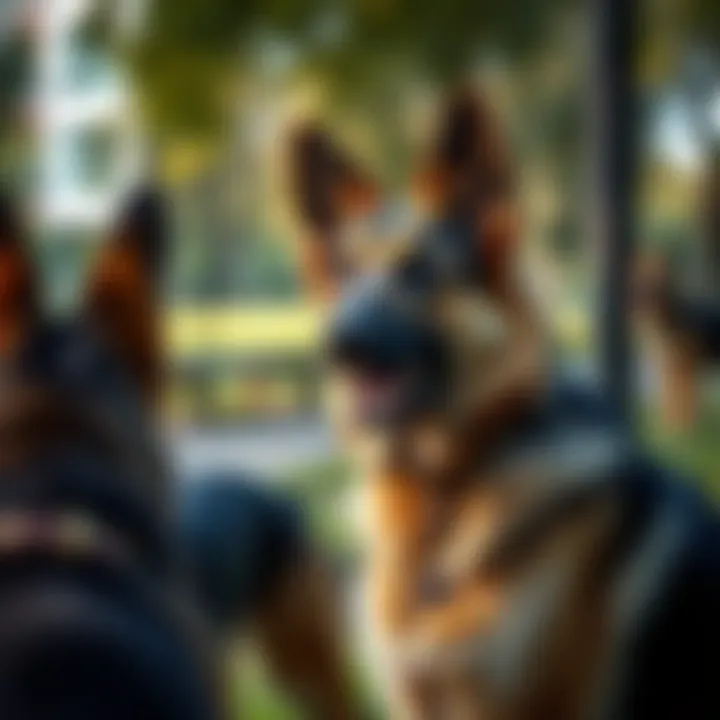
Here are several behavioral traits typical among German Shepherds:
- Protective Nature: They are known to protect their homes and families fiercely, which can, in some cases, lead to aggressive responses if they deem it necessary.
- High Intelligence: Their ability to learn quickly means they require both physical exercise and mental challenges to stay well-adjusted. Boredom can lead to misbehavior or biting.
- Sensitive Temperament: Many German Shepherds have an emotional sensitivity that influences how they respond to both humans and other animals. If a German Shepherd perceives a situation as threatening, their instinct might kick in to bite.
- Socialization Needs: These dogs thrive in social settings. If they aren't socialized properly, their lack of interaction can lead to fear-based reactions, which may result in biting.
To summarize, understanding these breed-specific behaviors and tendencies is crucial for any German Shepherd owner. By acknowledging what drives their actions, training becomes less about correcting faults and more about guiding the dog towards positive behaviors.
Recognizing Biting Behavior
Understanding biting behavior in German Shepherds is crucial for any dog owner, especially if they're handling a breed known for its intelligence and strong will. When you recognize the types of biting your dog exhibits and the situations that trigger this behavior, you lay the groundwork for effective training. By becoming attuned to these elements, you can take proactive steps to mitigate risks, enhance safety, and ultimately foster a more positive relationship with your canine companion.
Types of Biting: Playful vs. Aggressive
Not all bites carry the same intent. In dogs, two distinct types are prevalent: playful biting and aggressive biting.
- Playful Biting: This behavior often surfaces during playtime when dogs use their mouths in a way that might seem aggressive but is not intended to harm. Typical scenarios may involve chasing balls, tugging on toys, or wrestling with human companions. A playful bite usually lacks the force or intent to injure and is often accompanied by a wagging tail and relaxed body language, signifying enjoyment.
- Aggressive Biting: In contrast, aggressive biting is marked by higher levels of tension, both in muscle and temperament. Such outbursts may stem from fear, protectiveness, or territorial instincts. Signs of aggression often include a stiff posture, growling, or baring teeth, and the bite can certainly be harmful. It's essential to distinguish between the two, as confusion can lead to mismanagement and escalation of aggressive behavior.
Knowing the difference helps dog owners act accordingly, ensuring a proper response rather than inadvertently reinforcing negative behavior.
Identifying Triggers of Biting
Deriving from environmental or social cues, triggers play a pivotal role in when and why a German Shepherd may resort to biting. Identifying these triggers is akin to solving a puzzle—understanding the components can give you insights into your dog's psyche.
- Fear or Anxiety: Many biting incidents arise from fear. Loud noises, unfamiliar situations, or new people can send a normally friendly pup into a defensive mode, leading to bites as a response to perceived threats. For example, if your dog reacts aggressively toward delivery personnel, the trigger here is likely their sudden arrival and not your dog’s dislike of strangers.
- Overstimulation: Sometimes, pets become overwhelmed during play, leading to biting as a way to communicate their discomfort. An excited dog might nip during a bout of play when the energy levels run high.
- Possessiveness: German Shepherds can exhibit possessive behavior over toys, food, or their humans. This possessiveness can trigger biting if they feel their claim is threatened. A dog that growls when approached during mealtime is expressing a clear signal that they are not comfortable with close proximity.
Ultimately, noticing these behavioral cues and contexts where biting occurs can help owners redirect actions and consistently reinforce healthier responses. Recognizing the nuanced distinctions between playful and aggressive biting, along with their triggers, frame the foundation for effective management and training.
"An ounce of prevention is worth a pound of cure." This saying rings true here, allowing you to prevent biting before it becomes a larger issue.
By addressing biting behaviors within the context of play versus aggression, and keenly observing the triggers behind these actions, you’re well on your way to establishing a more harmonious dynamic with your German Shepherd.
The Importance of Early Training
Training a German Shepherd not to bite is much more effective when it begins early. This phase of a dog’s life is crucial, as it sets the foundation for their behavior and interactions with people and other animals. Early training can play a significant role in shaping a dog into a well-adjusted companion and ensuring a peaceful coexistence within the community.
Starting Training at a Young Age
Starting training when a German Shepherd is just a puppy is like planting a seed in fertile soil. During these early months, puppies are highly receptive to learning and socialization. Ideally, training should begin as soon as you bring the puppy home, typically around eight weeks old. At this age, they are curious and eager to explore their environment.
This training period allows the owner to teach basic commands and introduce the puppy to various stimuli. Instead of waiting until biting becomes a problem, addressing it during this formative phase promotes positive behavior. Simple commands such as "sit," "stay," and "no" can be introduced early on, and through patience and consistency, these commands become second nature.
Moreover, fostering positive experiences during this stage is pivotal. For instance, allowing a young shepherd to meet other dogs and people in a controlled manner can help them develop confidence and reduce fear-induced biting later on. Exposing them to different sounds, sights, and smells without force can greatly enhance their adaptability.
Critical Socialization Periods
Socialization is a buzzword in dog training, especially for German Shepherds, and for a good reason. Puppies undergo various critical socialization periods, usually spanning from about three weeks to 16 weeks of age. During this time, their brain is like a sponge, absorbing everything around them. Introducing your puppy to different environments, situations, and companions within this timeframe is essential.
- Three to Five Weeks: This stage is all about getting them used to human interactions. At this stage, it’s vital to ensure they experience gentle handling from different people to prevent fear-based reactions as they grow.
- Five to Twelve Weeks: This is when socialization should be in full swing. Encourage interactions with other friendly dogs and expose your puppy to various sights and sounds. Whether it’s a walk by a busy road or a visit to a pet-friendly store, these experiences can hugely impact their comfort level around new stimuli.
- Twelve to Sixteen Weeks: By this age, the focus should shift slightly to reinforcing the training commands and also exposing them to more complex scenarios, such as meeting larger animals or experiencing more chaotic environments.
A well-socialized puppy is less likely to exhibit aggression as an adult, and training during these critical periods will equip them with coping mechanisms in potentially stressful situations. Ultimately, a little patience and proactive training can nudge your German Shepherd in the right direction, ensuring that your future as companions is filled with mutual respect and understanding.
"A well-trained dog is a happy dog. Early training is not only about teaching commands; it’s about building a trusting relationship."
In summary, investing time and effort in early training pays off significantly. Addressing biting behavior before it escalates is not merely beneficial; it is essential for long-term harmony. Each one of these early training steps contributes to the overall development of a balanced and well-mannered canine companion.
Basic Commands to Implement
Implementing basic commands is a cornerstone in training your German Shepherd to avoid biting. These commands create a foundation for communication between you and your dog, fostering respect and understanding. When your dog comprehends what you expect from them, it significantly reduces the chances of misunderstandings that can lead to unwanted biting behavior. Commands like "No," "Leave It," and "Sit" are not just instructions; they empower your dog to make correct choices in various situations, which is crucial for their development.
Establishing this level of communication can also enhance your dog's confidence. They need to understand that you are their leader, and clear commands provide structure, which allows them to feel secure in their environment.
Teaching 'No' and 'Leave It'
One of the most vital commands to master is "No." This command acts as a clear signal for your dog, indicating that a particular behavior is inappropriate. Teaching "No" can begin at an early age; however, it is effective if applied consistently.
To successfully teach this command, a firm but calm tone is essential. When your German Shepherd attempts to bite or engage in undesirable behaviors, use the command "No" immediately after the action. Reinforce this by redirecting your dog's attention to acceptable alternatives, providing them a clear understanding of what is expected.
"Leave It" is another powerful command that instructs your dog to ignore or disengage from a tempting distraction. This can be particularly important when your German Shepherd encounters objects or situations that may trigger their biting instinct.
- Start by showing your dog a treat in your hand.
- Say "Leave It" firmly but without showing frustration.
- When they turn their head away or stop trying to get it, praise them, and offer an alternative treat once they comply.
This not only reinforces good behavior, but it creates a mental pathway for your dog, allowing them to associate rewards with compliance.
The 'Sit' Command and its Benefits
The "Sit" command is one of the simplest yet most beneficial commands to teach your German Shepherd. It not only establishes a basic level of obedience but also creates a calm disposition that can prevent biting incidents during high-energy moments.
To teach this command:
- Hold a treat in front of your dog’s nose.
- Move your hand upwards, allowing their head to follow the treat, causing their bottom to lower.
- As soon as they sit, say "Sit" and give them the treat along with verbal praise.
This command comes in handy in various situations, whether it’s stopping a potential biting incident during chaotic moments or preparing for introductions with new people. It instills a sense of calm and compliance in your dog, resulting in better behavior overall.
Using Positive Reinforcement
Positive reinforcement is an effective method for encouraging desired behaviors in your German Shepherd. This training technique revolves around rewarding your dog immediately following a correct action, making it clear what behaviors will earn them praise or a treat.
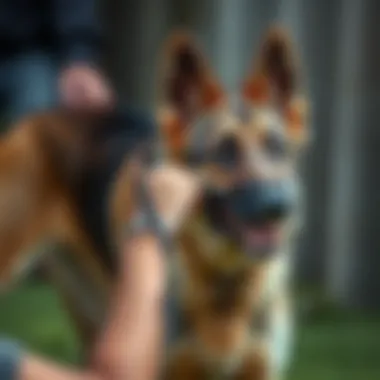
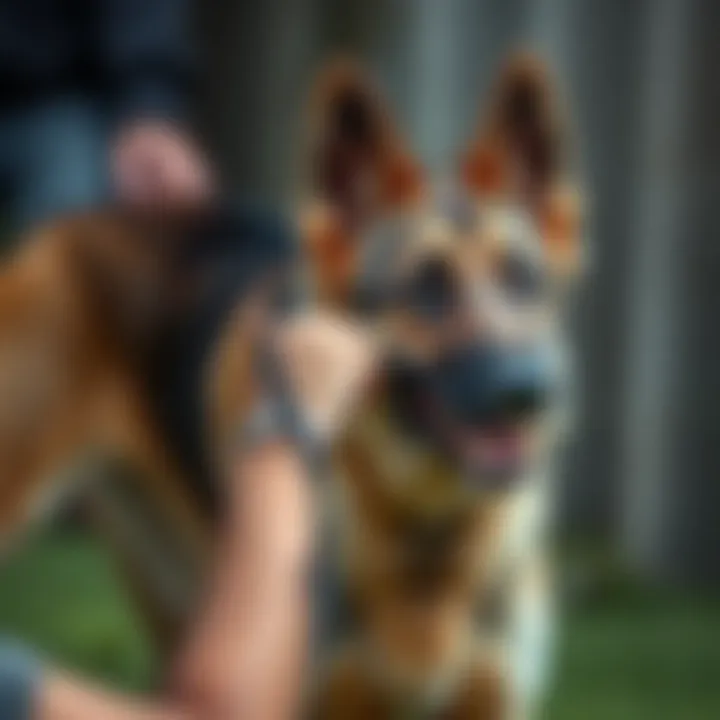
This method not only enhances the bond between you and your dog but also fosters a joyful learning environment. For instance, if your dog abstains from biting or engages in appropriate play, a reward can motivate them to repeat that behavior.
Using positive reinforcement also reduces fear and anxiety often associated with corrections. This approach encourages a dog to look to their owner for guidance, which is essential in building a relationship based on trust and respect.
"A well-mannered dog is a joy to have, ensuring a peaceful environment for both pets and their owners."
Utilizing these techniques early on sets the standard for successful interactions as your dog matures.
Effective Training Techniques
Training techniques that are effective can make a world of difference in shaping your German Shepherd’s behavior. As they are intelligent and eager to please, utilizing proper methods helps reinforce positive habits while addressing biting tendencies directly. The effectiveness of training is amplified when the owner remains consistent and attentive. By combining several tactics, you are better positioned to cultivate a trusting and respectful relationship with your dog while promoting safety in various situations. This is particularly essential given the breed's natural instincts and strong personality.
Behavior Shaping through Rewards
One of the most powerful tools in your training arsenal is the use of rewards. This concept, known as positive reinforcement, is centered on encouraging desired behaviors by offering treats, praise, or playtime when your dog exhibits good behavior. The idea is straightforward: if your German Shepherd recognizes that certain actions result in something enjoyable, they’re likely to repeat those actions.
For example, if your dog plays gently or listens to commands without showing signs of aggression, reward them immediately after the desired behavior occurs. Doing this creates a connection in their mind between their actions and the positive feedback they receive. This method not only helps deter biting but reinforces their self-control and reliance on your guidance.
- Key Benefits of Reward-Based Training:
- Build trust and rapport with your dog.
- Encourage repeat behaviors that lead to positive outcomes.
- Instill a sense of accomplishment and motivation in your pet.
One must remember that the timing and appropriateness of the reward matter significantly. A reward must be given at the right moment to ensure the dog associates their behavior with the treat or praise.
Redirecting Attention to Toys
Redirecting your German Shepherd's focus to toys can effectively minimize unwanted biting. As sharp as a tack, German Shepherds tend to channel high energy into various behaviors, including biting. When you notice play biting beginning, quickly introduce a toy to divert their attention. This approach serves a dual purpose by providing a constructive outlet for their energy while reducing the multitude of situations that could lead to aggressive play.
Consider using a variety of toys to keep things interesting. Tug toys, chewable items, or even fetch toys can be great distractions. When your German Shepherd begins to bite your hands or clothing, grasp their favorite toy and engage them in play instead.
- Strategies for Effective Redirection:
- Keep Toys Accessible: Ensure that different toys are readily available for spontaneous activities.
- Create Play Sessions: Use intentional playtime as a way to consistently redirect their energy.
- Praise for Choosing Toys: When they grab a toy instead of opting to bite, praise them enthusiastically to emphasize the behavior you want.
By showing that toys are the preferred option, your dog learns to channel their energy more positively while enjoying their time with you.
Consistency in Commands
Consistency is key when it comes to vocal commands and hand signals. Using the same word or signal for the same action helps solidify understanding for your dog, ensuring they learn what to expect from you. For a German Shepherd, commands like "No!" should be used consistently every time biting behavior occurs. Inconsistency can lead to confusion, where your dog may not fully comprehend what is expected of them.
Establishing a set of clear, concise commands such as "Stop," "Leave it," or "Sit" enables your dog to correlate each command with a specific action. Over time, they will recognize these commands as not just words but as direct directives that influence their activities.
- Tips for Maintaining Consistency:
- Use the same commands with all family members involved in training.
- Incorporate gestures that align with your verbal commands to strengthen communication.
- Avoid using commands that sound similar to others to reduce confusion.
Maintaining consistency will lead to improved engagement from your dog, paving the way for a safer and more harmonious living environment.
"Training a dog takes time and effort, but the rewards are immeasurable. A well-trained dog is a joy to have at home."
By employing these effective training techniques, you are not only addressing the immediate issue of biting but also laying foundational skills that are essential for your German Shepherd’s overall behavior and well-being.
Addressing Fear and Anxiety
Fear and anxiety are underlying factors in many behavior problems exhibited by dogs, particularly in breeds like the German Shepherd. These emotions can lead to biting as a fear response, often escalating into more severe aggression if unaddressed. Understanding and tackling these issues head-on is vital for creating a well-adjusted and reliable companion.
Understanding Fear-Based Biting
Fear-based biting usually emerges when a dog encounters situations or stimuli that trigger their anxiety. For German Shepherds, this could be anything from loud noises, unfamiliar people, or even certain environments. Their innate protective instincts can contribute to this behavior, as they may feel threatened and react defensively.
It's important to recognize the signs of fear in your pup. Common indicators include:
- Cowering or hiding
- Growling or snapping when approached
- Tucked tails or flattened ears
Identifying these signs is crucial as they can often be mistaken for aggression. In fact, often these dogs are not trying to be dangerous but are simply trying to protect themselves from what they perceive as a threat. Eliminating the trigger as much as possible and offering plenty of reassurance can greatly help alleviate their fears.
Creating a Safe Environment
Your home should be a sanctuary for your German Shepherd, especially if they struggle with fear and anxiety. A safe environment reduces stress and builds trust, allowing for more effective training and socialization opportunities.
Here are some key steps to create this space:
- Designate a Safe Area: Set up a cozy spot where your dog can retreat when feeling overwhelmed. This can be a crate or a specific corner of a room filled with their favorite toys and a comfy bed.
- Minimize Stressors: Identify and limit exposure to potential stressors within the home. If certain noises, like loud music or sudden kitchen clatter, tend to set off anxious reactions, find ways to lessen their impact.
- Routine is Key: A predictable routine can provide a sense of security for your dog. Knowing when to expect meals, walks, and playtime can help alleviate anxiety associated with uncertainty.
"Animals are not just our companions; they are our teachers, guiding us through the complexities of their world."
For those interested in deeper insights on canine behavior, consider resources like American Kennel Club or ASPCA.
Socialization with Other Pets and People
Socialization is key when it comes to shaping a well-adjusted German Shepherd. Exposing your dog to various environments, sounds, and a crowd of people can have a significant impact on behavioral traits. The importance of socializing your German Shepherd can't be overstated; it not only helps to reduce biting tendencies but also enhances their adaptability and lowers potential anxiety in unfamiliar situations.
- Benefits of Socialization:
- Considerations about Socialization:
- Improved Behavior: When dogs are accustomed to being around other animals and people, they are less likely to exhibit fearful or aggressive behaviors. This helps in curbing biting incidents.
- Confidence Building: A well-socialized dog tends to be more confident and relaxed in different settings, reducing the likelihood of aggressive responses.
- Enhanced Learning: Interaction with a diverse array of social situations allows your dog to learn how to behave appropriately, making training more efficient.

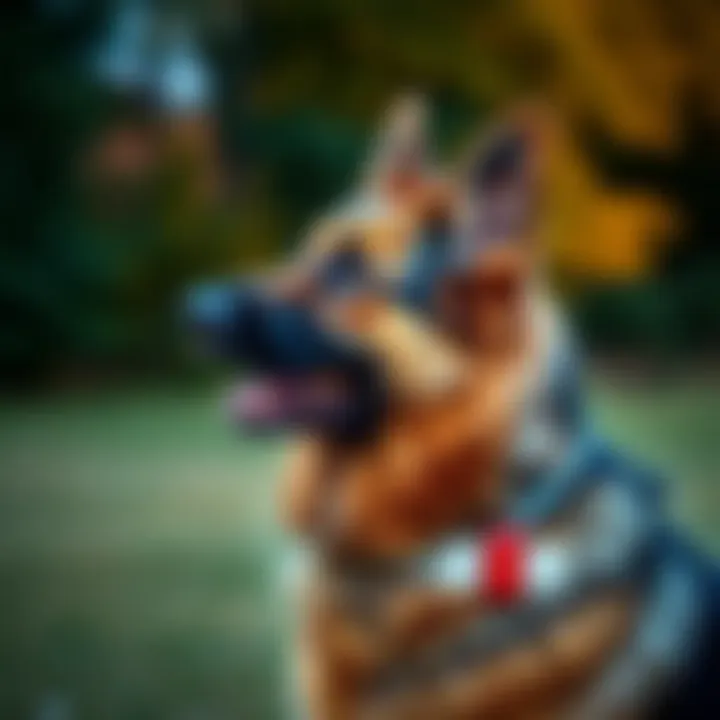
- Timing is crucial; begin socialization as early as possible, ideally during puppyhood, when they are more receptive to experiences.
- Always monitor their interactions, especially at the initial stages. The experiences they have can either reinforce or undermine their training.
Introducing Your German Shepherd to New Situations
When introducing your German Shepherd to new situations, proceed with care and patience. Think of this as a gradual journey rather than a race. Start by taking your dog to various public places, parks, pet-friendly cafes, and even family gatherings where they can meet unknown faces and voices.
- Gradual Exposure: Gradual introduction is vital. Begin in a low-stress environment and slowly increase the complexity of situations. For example, you might start with a quiet park before moving to a bustling street.
- Using Treats and Praise: Leverage the power of positive reinforcement. Reward your dog when they display calm behavior around new stimuli, affirming that those situations are safe and non-threatening.
Being mindful of your dog's comfort level is critical. If your German Shepherd appears uneasy, take a step back. Assess the situation and give them time to adjust.
Supervised Interactions with Other Dogs
Supervised interactions are another essential pillar in the socialization process. Direct interactions with other dogs teach your German Shepherd how to communicate and recognize social cues, which is paramount in preventing unwanted bites. It's crucial to control these encounters for the safety of all involved.
- Choose the Right Playmates: Ensure that the other dogs are friendly and well-adjusted. This guidance helps your dog feel secure, reducing fear-based or aggressive reactions. Look for calmer breeds to ease up your dog into the interaction.
- Keep Interactions Short: Especially during the initial meetings, keep the interactions to a reasonable length to avoid overstimulation. Gradually increase the duration as your dog becomes more comfortable.
Overall, actively supervising these sessions keeps your German Shepherd safe and allows you to intervene, should any undesirable behavior arise.
The End
Mastering socialization takes time and commitment, but it paves the way for a well-rounded, non-biting German Shepherd. Owners who invest in their pet's social education are ultimately rewarded with a safer and more harmonious living environment.
Monitoring Progress and Adjusting Techniques
Training a German Shepherd not to bite is much like steering a ship through changing waters. As with any training, the importance of monitoring progress and adjusting techniques cannot be overstated.
In this section, we will explore how to document your training journey, assess the effectiveness of your methods, and adapt strategies as needed.
Keeping a Training Journal
One of the simplest yet most effective ways to track your dog's training is to keep a training journal. This practice involves noting daily or weekly observations and any changes in behavior. Writing things down not only helps reinforce your memories but also provides concrete evidence of your dog’s progress. When you encounter a setback, you can review past entries and identify patterns or triggers that might have gone unnoticed.
Some key points to include in your journal:
- Dates and times of training sessions
- Specific tasks or commands practiced
- Reactions from your German Shepherd
- Any distractions present during the exercises
- Moments of success, however small
This log can unveil trends—like whether your dog reacts positively more often in a particular setting, or what distractions consistently lead to biting behavior. A journal can serve as a turning point, making it easier to have an unbiased look at the training process.
Assessing the Effectiveness of Training Methods
It’s crucial to periodically assess the effectiveness of training methods employed. Frequency of bite incidents can be a direct indicator of success or failure. If a certain technique seems to be hitting the mark, great! But if you find yourself backpedaling, it might be time to rethink your strategies.
To assess effectively:
- Set Clear Goals: Decide what an acceptable level of behavior looks like. Is your dog responding well to commands? Are they less inclined to nip?
- Use a Score System: Rate your dog’s performance, say from 1 to 10, after each session. This can help provide a numerical perspective on improvements over time.
- Involve Others: Sometimes, friends or family can provide outside perspectives on your dog's behavior that you might overlook.
In some cases, especially if it’s more than just a training issue, you may need to consider other factors affecting behavior, such as health or changes in the environment.
"Training a dog requires patience and attention to detail. Keeping a journal simplifies your task and helps track successes and challenges alike."
Monitoring progress and adjusting techniques is not just about tracking numerical success; it’s about having a clear understanding of the bond between you and your German Shepherd. As they grow and evolve, so too should your methods, ensuring a positive path forward.
When to Seek Professional Help
Understanding when to reach out to a professional dog trainer is crucial in the journey of curbing your German Shepherd's biting behavior. The nature of this breed requires a nuanced approach, especially when issues arise that you may feel ill-equipped to handle alone. Seeking professional help can provide distinct benefits, from enhancing your training outcomes to ensuring a safe environment for everyone involved. A timely intervention can make all the difference.
Recognizing Signs of Aggression
A key aspect of knowing when to get professional guidance is recognizing the signs of aggression in your German Shepherd. While playfulness might often be mistaken for aggression, there are subtle differences that are critical to discern.
- Growling and Snapping: If growling becomes frequent or your dog snaps at people or other animals, it may signal underlying fear or dominance issues. These behaviors can escalate if not addressed promptly.
- Stiff Body Language: An aggressive dog often exhibits a rigid posture, with ears pinned back and hackles raised. Such body language can indicate a readiness to bite, even if your dog hasn’t actually bitten anyone yet.
- Protective Instincts: If your dog begins to guard food, toys, or territory aggressively, this can quickly lead to biting incidents. Recognizing this sooner rather than later is essential.
Pay attention to these behaviors and be proactive. Catching these signals early can save you from potential dangers down the line.
Finding a Qualified Trainer
Once you've assessed the situation and determined that professional help is warranted, locating the right trainer becomes your next challenge. Not all trainers have the expertise or approach that suits every dog's needs. Here are factors to consider:
- Experience with German Shepherds: The ideal trainer should have specific experience with the breed. Understanding their instincts and behavior can make a fundamental difference in training outcomes.
- Training Methodology: Methods vary widely among trainers. Look for one who employs positive reinforcement techniques rather than punishment-based methods. Positive approaches cultivate trust and promote more lasting behavior changes.
- Credentials and Reviews: Checking the trainer’s credentials and client reviews can provide assurance of their capabilities. Look for trainers affiliated with reputable organizations like the Association of Professional Dog Trainers (APDT).
Engaging with a qualified trainer not only offers specialized knowledge but also a support system to help navigate through challenging behaviors. With diligent work from both you and the trainer, you can lay a solid foundation for a peaceful coexistence with your faithful companion.
"Training a dog isn’t just about teaching commands; it’s about understanding their world."
Maintaining Positive Long-term Behavior
Maintaining positive long-term behavior in your German Shepherd isn't merely a goal; it’s a vital part of fostering a healthy partnership between you and your dog. It’s like sailing a ship—once you catch the wind right, you need to keep that momentum going to reach your destination without hitting any bumps. A consistent, supportive training routine not only curbs undesirable behaviors but also sets a foundation for a well-adjusted canine companion.
Continuous Reinforcement and Practice
The journey to a well-behaved dog involves continual reinforcement and persistent practice. When we talk about reinforcement, we reference strategies like rewarding your dog for good behavior. Treats, praise, and affection serve as encouragement, turning the learning process into a rewarding experience.
- Establish a Routine: Regularly scheduled training sessions help your dog understand expectations. Just like how humans benefit from habits, dogs thrive in a structured environment.
- Mix It Up: While consistency is essential, varied activities keep the training fresh. Integrate activities such as agility training or scent work, which not only improves obedience but also engages your dog's natural instincts.
It's crucial to note that different dogs might respond to various types of reinforcement. For some, a tasty treat might be the key, while others may react more favorably to praise or a favorite toy. Pay close attention to what resonates with your pooch.
"Training your dog is like teaching a child; patience and reinforcement are the keys to success."
Adapting to Changing Behavior as the Dog Grows
As your German Shepherd matures, its behavior will evolve. Awareness of these changes is paramount. Think of your dog’s development phases like chapters in a book; each one builds on the previous stage and carries its own challenges and triumphs.
- Behavioral Shifts: A young puppy's exuberance might transform into territorial instincts as they approach adulthood. Adjust your training techniques to align with these shifts. What worked for an excited pup may not suit a more assertive adult.
- Tailor Your Approach: Be proactive. For instance, if your young adult shepherd starts showing signs of guarding behavior, redirect that instinct through socialization or structured activities.
- Reinforce Old Commands: As behaviors change, old commands may need reinforcing. Regularly practice basic commands and refresh your dog’s memory so they remain second nature.
Ultimately, the foundation of strong long-term behavior stems from your ability to adapt, stay observant, and adjust your training methods as needed. By understanding these changing dynamics and addressing them, you will maintain a healthy, safe, and positive relationship with your German Shepherd.







